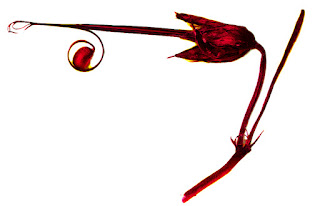While chasing Sheila the Shield Bug around the geraniums I noticed the flower’s ornate seed heads. That lovely curl wouldn’t look amiss on an iron gate, or an elegant art nouveau copper lamp. My dream ‘Arts and Crafts mansion’ (doesn’t everyone have one?) would definitely have shapes like that somewhere in it.
In reality what is happening here is very interesting.
Unlike the daisies we looked at before the geranium doesn't lie back once the seeds have been generated and passively let wind or animals disperse them. It's involvement is more active.
The seeds themselves form against a long column, or 'beak', that grows up from the old flower head. When they are ripe the beak splits and springs each seed upwards. The force of this movement should be enough to fling the seeds a distance away from the main plant.
Which doesn't seem to have happened in the above picture.
Here are a couple of diagrams that explain my understanding of the action.
Having dealt with the science bit we can return to the world of imagination.
As I'm sure you are aware the other name for geraniums is cranesbill. I think the pink ones growing in Garden65 are wood cranesbill (Geranium sylvaticum). And why are they called cranesbill? Because that column that flings the seeds away reminded someone sometime of a 'crane's bill'. It's not called a beak for nothing.
 |
| Source |
I wonder who originally thought of that connection. Was it some peasant walking in a woodland in late summer who picked a geranium, saw the shape of the seed head, then glanced up over the nearby marshy fields towards a group of cranes and thought, "That looks like that. From now on I'll call this plant 'cranesbill'"? Would it happen like that? Or maybe the scientist who formally identified the plant and added it to his grand taxonomy scheme whimsically gave it an amusing name. I wonder what it is called in other countries.



